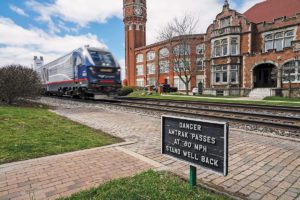
Chelsea Milling Co., aka Jiffy Mix, is one of only two area companies still receiving deliveries by rail. Photo by Steve Brown
On July 4, 1841—the day the first train arrived in Dexter—crowds began gathering early in the morning. They came from all around the surrounding area by foot, horseback, carriage, and wagons. Few, if any, had ever seen a train before, because they were in their infancy in the United States. The first track had been laid in Baltimore just eleven years previously.
An eyewitness quoted in the 1881 County History recalled the scene: “We had but a few minutes to wait before the shrill whistle of the iron horse was heard, and instantly the train came in its grandeur and majesty around the curve into full view, and thundered up to the depot, when the air was filled with huzzas and shouts of welcome, and everyone was happy.”
The train was filled with dignitaries from Detroit and the towns that the train had already passed through. The day was spent celebrating with speeches from many of those dignitaries, starting with the town’s founder, Samuel Dexter. A marching band provided music.
It wasn’t just the novelty that excited people: everyone knew that the train would bring many benefits. There were at that time small hamlets scattered about Washtenaw County, any one of which might have become a regional economic center, so having a train stop was a major advantage.
The settlers who celebrated the train’s arrival had themselves arrived by foot or on horseback. The only way to transport freight between towns was in horse-drawn wagons, over dirt roads that turned to mud every spring. Since teams pulling heavy loads had to be changed every four to six hours, and replaced every three or four years, farmers and manufacturers were pretty much limited to small, local markets.
The railroad would make it much easier for future immigrants to reach Dexter, aiding the growth of the town. Farmers would be able to buy better tools and supplies, grow more crops, and sell them in larger markets. Eating places, hotels, and later factories would grow up around the station, also adding to the town’s economic health.
Town leaders were well aware of these advantages and lobbied to get stations located in their communities. By 1850, Chelsea was celebrating its own station, and in 1870, a different line reached Saline.
If not for their railroad stations, Dexter and Saline would have been much less important—and Chelsea wouldn’t exist.
—
The train that arrived in Dexter was the Michigan Central, which was building a railroad across Michigan using “strap rails,” so called because they were made of wood topped with iron straps.
It had reached Ann Arbor two years previously, and came to Dexter due to the efforts of Samuel Dexter. He had moved west from New York state hoping to shake the depression that followed the death of his wife and son. Well educated, he quickly became a community leader and was appointed the first Washtenaw County judge. Always a booster for his town, he donated land to the railroad even though it meant the tracks would come through his back yard. Years later, his daughter, Julia Dexter Stannard, had a childhood memory of sitting in her back yard and seeing men chop down their pear and apple trees. “It always made me sad,” she recalled.
Passenger trains came to Dexter twice a day and later added a night run after the introduction of oil-burning headlamps. According to the Dexter history, it was not uncommon for fifty or sixty immigrants to get off each time the train stopped. The first station was a small building on the north side of the tracks.
—
Continuing west, the train passed right through what is now Chelsea, but was then just a wagon road with the farms of brothers Elisha and Jim Congdon on either side of the tracks. The nearest stop to the west was at a small watering station known as Davidson’s Station. After teenage pranksters destroyed it, the Congdon brothers offered the railroad free land for a station, which was built in 1850.
Once the station was there, the post office followed, since the mail arrived and went out by train. People from the nearby towns of Pierceville and Kedron, which could have developed into the area’s market towns, instead moved to Chelsea.
Thanks to the railroad, Chelsea became the largest shipper of wool in the state, serving the many sheep farmers in the area. The former Pierceville is now part of Chelsea, while Kedron has disappeared.
The ease of shipping also attracted industry. In 1874, a flour mill opened. Flour milled in Washtenaw County would eventually be shipped as far away as Europe. The mill was later acquired by the Holmes family, who still make their Jiffy Mixes there.
In 1891 local banker Frank Glazier built a stove factory on the north side of the railroad. The railroad was used not just to ship stoves out, but also to bring in workers—some of the county’s earliest commuters.
—
Saline did not get a railroad until 1870, as it was located south of the path followed by the Michigan Central and north of another railroad, the Lake Shore and Michigan Southern, which passed though Michigan’s southern tier of counties. When it finally got a railroad, it was a route that connected those two lines.
In the economic boom after the Civil War, thirty-two local farmers and Saline merchants signed a petition asking for a railroad and pledging to buy stock if it were built. The result was the Detroit, Hillsdale, and Indiana.
The name was mostly aspirational, since it never reached either Detroit or Indiana. But it did connect Saline northeast to Ypsilanti and southwest to Hillsdale, where freight and passengers could transfer to the Michigan Central or Michigan Southern.
Like the Michigan Central in Dexter, it was welcomed with a community-wide celebration. “The road has been of great convenience to the citizens of the village and of all the country tributary,” reported the 1881 County History. “It opened up a market for the production of the country, enabling farmers and others to realize handsomely on all their investments.”
The glowing history didn’t mention that within a few years, the Detroit, Hillsdale, and Indiana had been foreclosed for unpaid debts. According to an online presentation by journalist Bob Conradi, the entire line was then sold for less than the Saline backers alone had put into it.
Even at that price, the new owners couldn’t make it work. The same year the history came out, they stopped operating their own engines and leased the track to the Lake Shore and Southern Michigan. That’s the line whose “LS & MS” livery decorates a caboose permanently parked at the Saline Depot Museum.
“The last passenger service was in 1931,” Conradi writes, “and the tracks began to be taken up in the 1960s.” But part of its right-of-way can still be seen, and even walked, as the Library-Brecon Trail.
The Ann Arbor Railroad, which passes east of downtown Saline, played a more lasting role in its business history. At its peak, the “Annie” ran from Toledo to Frankfort, then across Lake Michigan to Wisconsin on its own fleet of rail-car ferries. Though now its portion of the track now ends in Ann Arbor, it still serves the Faurecia auto-parts plant—with Jiffy Mix, one of only two businesses in the area that still ship by rail.
—
Saline is the only town of the three towns that still has its original station, although there have been a few changes to the front. In 1880, the Michigan Central built a new much fancier station for Chelsea, following in 1886 with one for Dexter.
The Chelsea station was designed by Detroit architects Mason and Rice, whose most famous project is Mackinac Island’s Grand Hotel. They worked in what is called “stick style,” characterized by lots of external wood trim, or stickwork, some of which has since been removed. It had two waiting rooms, one for men and another for women and children.
For the Dexter Station, Michigan Central hired Spier and Rohns, the Detroit architects who the same year built a new station in Ann Arbor (now the Gandy Dancer restaurant). It was located on the south side of the track, probably so the old one on the north side could continue being used while it was being built. It also had two waiting rooms, and of course a ticket office and a baggage room.

Amtrak passenger trains still roar through Chelsea and Dexter, but the closest stops are in Jackson and Ann Arbor. Photo by J. Adrian Wylie
Both new stations were carefully landscaped using plants the railroad grew in its own nurseries in Ypsilanti and Niles. The imposing structures and well-tended grounds gave visitors a positive first impression, and established the railroad as an important community asset even for people who never rode it. They were favorite backdrops for people taking group pictures.
—
The former Michigan Central track is now owned by the Michigan Department of Transportation, which has been upgrading it to speed Amtrak’s passenger trains between Detroit and Chicago. The Ann Arbor Railroad is owned by a holding company in Kansas.
But the importance of the railroads in the county’s early days is not forgotten: all three communities have restored their stations and have found new uses for them.
The Chelsea Depot is available to rent for events. The Dexter Station is used by the Ann Arbor Model Railroad Club, which has a giant layout that includes all the stations along the Michigan Central. And Saline’s station has been turned into a museum for the Saline Area Historical Society (see Saline Attractions).
They’ve moved a period-correct barn to the site, and enlisted a local Boy Scout troop to build a pedestal for a Saline-made windmill. The site is open to the public, and the depot is open on Saturdays from 11 a.m. to 3 p.m.


